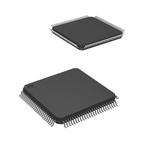Description
●Part numbers for the chip have fields that identify the specific part. You can use the values of these fields to determine the specific part you have received.
●Features
●• Operating Characteristics
●– Voltage range: 1.71 to 3.6 V
●– Flash write voltage range: 1.71 to 3.6 V
●– Temperature range (ambient): -40 to 105°C
●• Performance
●– Up to 100 MHz ARM Cortex-M4 core with DSP instructions delivering 1.25 Dhrystone MIPS per MHz
●• Memories and memory interfaces
●– Up to 512 KB program flash memory on non FlexMemory devices
●– Up to 256 KB program flash memory on FlexMemory devices
●– Up to 256 KB FlexNVM on FlexMemory devices
●– 4 KB FlexRAM on FlexMemory devices
●– Up to 128 KB RAM
●– Serial programming interface (EzPort)
●– FlexBus external bus interface
●•Clocks
●– 3 to 32 MHz crystal oscillator
●– 32 kHz crystal oscillator
●– Multi-purpose clock generator
●• System peripherals
●– 10 low-power modes to provide power optimization based on application requirements
●– Memory protection unit with multi-master protection
●– 16-channel DMA controller, supporting up to 64 request sources
●– External watchdog monitor
●– Software watchdog
●– Low-leakage wakeup unit
●• Security and integrity modules
●– Hardware CRC module to support fast cyclic redundancy checks
●– 128-bit unique identification (ID) number per chip
●• Human-machine interface
●– Low-power hardware touch sensor interface (TSI)
●– General-purpose input/output
●• Analog modules
●– Two 16-bit SAR ADCs
●– Programmable gain amplifier (PGA) (up to x64) integrated into each ADC
●– 12-bit DAC
●– Three analog comparators (CMP) containing a 6-bit DAC and programmable reference input
●– Voltage reference
●• Timers
●– Programmable delay block
●– Eight-channel motor control/general purpose/PWM timer
●– Two 2-channel quadrature decoder/general purpose timers
●– Periodic interrupt timers
●– 16-bit low-power timer
●– Carrier modulator transmitter
●– Real-time clock
●• Communication interfaces
●– USB full-/low-speed On-the-Go controller with on chip transceiver
●– Two Controller Area Network (CAN) modules
●– Two SPI modules
●– Two I2C modules
●– Four UART modules
●– Secure Digital host controller (SDHC)
●– I2S module


